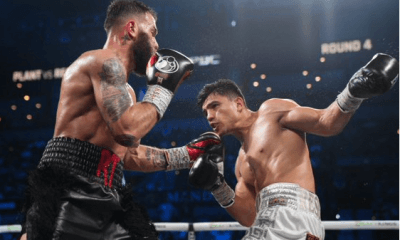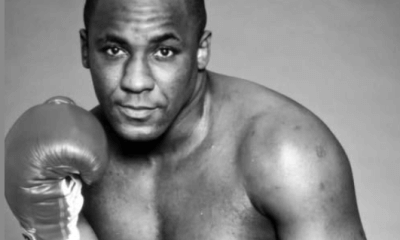Articles of 2006
A Hard Left Hook to the Ali Myth
Muhammad Ali was the most exciting athlete of the last half of the 20th century. The drama of his career, his engaging persona, and his ring wars with Joe Frazier, Sonny Liston, George Foreman, Floyd Patterson, and Ken Norton have left a void that boxing is still unable to fill 25 years after his retirement.
In the years following his final fight with Trevor Berbick in 1981, Ali has served as an icon of both humanitarianism and civil rights. Most recently, he was awarded the Presidential Medal of Freedom in 2005.
Yet many believe the sanctity of Ali is a product of the selective, short-term memories of the New Left. In Jack Cashill’s book, “Sucker Punch: The Hard Left Hook that Dazed Ali and Killed King’s Dream,” Ali’s accolades do not extend beyond the ring.
As a man, Ali has become virtually immune from criticism. His athletic accomplishments are beyond question, but the beliefs, ideals, and motivations that have immortalized him are not. Unfortunately, it is not an area many writers are willing to explain. As former heavyweight champ Larry Holmes bluntly put it, “[Ali] wasn’t a saint. But if you tell people something like that they kick your a–. You can’t talk bad about Muhammad Ali.”
According to Cashill, that is a result of the media’s refusal to question his flaws and the liberal championing of Ali as a revolutionary. Throughout his career, writers ignored Ali’s association with the violence and hatred preached by the Nation of Islam, his chauvinistic feelings towards women, unabashed philandering and the cruel, racially tinged treatment of fighters like Frazier, Patterson and Ernie Terrell.
The first book to seriously question the Ali myth was the late Mark Kram’s scathing Ghosts of Manila, published in 2001. Kram covered Ali for Sports Illustrated in the 1960s and 70s and much of his narrative came from firsthand accounts. While the book is brutally harsh at times, it reveals points that other Ali biographers have simply brushed over. The most shocking story Kram tells is of Aisha Ali, a 17-year-old girl that the then 31-year-old Ali impregnated and married. Since Ali was already married at the time to his second wife, Belinda, the marriage could be considered an act of bigamy.
On a political scale, Kram was not any kinder. He wrote: “Seldom has such a public figure of such superficial depth been more wrongly perceived – by the right and the left; he (Ali) was reminiscent of the simple Chauncey Gardner in “Being There” by Jerzy Kosinski.”
Cashill’s book takes that analogy one step further. Gardner is a simpleton who experiences success by saying the right things at the right times to the right people. People knew nothing about his past.
Cashill feels that the New Left knew Ali’s background, ignored it and transformed him into a mythical revolutionary because of his stance on the Vietnam War. Only the what was important, not the why or who.
There seems to be a general sentiment among both conservatives and liberals that Ali gave up a great deal by refusing to go to Vietnam, where he likely would have never seen combat. There is no measure of the detriment it caused his boxing career.
At the age of 25, he was stripped of his title and would not fight for another three and half years. For boxers, the mid to late 20s are prime years. Because of that sacrifice, he is universally admired for standing up for his views.
On the surface, his reasons for not complying with the draft boiled down to his religious beliefs and unforgettable lines like “I ain’t got no quarrel with them Vietcong” and “No Vietcong ever called me n—–.”
However, in his autobiography, Sugar Ray Robinson tells the story of visiting a scared Ali in New York in 1967. When Robinson insisted that he had to go to Vietnam, Ali answered, “No. Elijah Muhammad told me that I can’t go.” Despite Robinson’s insistence, Ali tearfully explained that he was afraid. When asked if he was afraid of the Nation of Islam, he refused to answer. Robinson said Ali’s eyes were full of “tears of torment, tears of indecision.”
Was he scared that the Nation of Islam would kill him? If so, it was never explored by those who championed his position on Vietnam. Robinson certainly had no reason to lie either. He seemed more than willing to explore and share his own exploits. In the book, he admits that he himself committed adultery, squandered most of his ring earnings, and slapped his third wife in an argument. Robinson also described the young Ali as “one of the most likeable people I’ve ever known.”
Cashill never states his true belief of Ali’s refusal to go to Vietnam. He simply provides the relevant details and criticizes those who ignored them.
One blatantly disregarded fact is that Elijah Muhammad, the leader of the Nation of Islam, also refused induction into the military during World War II, but not for pacifistic reasons. Muhammad believed in Japanese superiority and repeatedly stated throughout the 1930s that “The Japanese will slaughter the white man.” At a speech in Chicago in 1942, he told followers, “The newspapers are lying when they say that the Japanese are losing. We are going to win.” By “we,” he meant the Japan/Nation of Islam axis that he had been touting.
This information is not sitting in a vault somewhere between the JFK Assassination files, Jimmy Hoffa’s body, and the pictures of the Roswell flying saucer. The Vietnam-era resisters who turned Ali into a revolutionary seemed to have a tunnel vision that has only narrowed over time. The stance on the War was all that mattered. Any flaws or contradictions were simply pushed to the side.
It is one thing to forgive one’s flaws for the sake of his accomplishments. It is another to ignore facts because they diminish your cause.
But ignoring readily is exactly what the New Left did in its coronation of a good-looking, brash, athletic champion. With that decision came the silent acceptance or ignorance of despicable behavior.
Cashill argues that the civil rights movements led by Dr. Martin Luther King and Malcolm X gave way to the violence and racial bigotry of the Nation of Islam. Its front man was Ali, who called for the segregation of America and executing interracial couples as late as 1975.
When the quieter civil rights pioneers like Joe Louis and Jackie Robinson opposed Ali’s ideals, they were called “Uncle Toms.” Obviously, this created divisions within the African-American community, which Ali only exacerbated with his treatment of Frazier.
When Ali was finally able to return to the ring in 1970, Frazier was the champion. Their epic 1971 match is a prime example of Ali’s squandered opportunities. It is the only time in history that two undefeated, undisputed heavyweight champions have ever squared off in the ring, and Ali diminished it by casting Frazier as a white man’s champion.
The endless racial epithets thrown by Ali only would continue over the next four years up to their final bell of their final fight sounded. At a press conference before their third match in Manila in 1975, Ali presented a gorilla as Frazier’s likeness and proceeded to beat on it, saying, “Wake up gorilla. We’re in Manila.” In the years that followed, many writers dismissed Frazier’s animosity towards Ali as inability to take a joke.
Also dismissed was Ali’s philandering. In many cases, it seems tabloid-like to focus on a person’s extramarital affairs. However, when a man refuses to go to war for the sake of his Islamic principles, then unapologetically desecrates the vow of holy matrimony countless times, skepticism is more than justified.
Still, the cultural elite never openly make that connection. Nor do they discuss the fact that as the New Left championed Ali and advocated the Equal Rights Amendment, their hero preached sexism. He told Playboy in 1975, “In the Islamic world, the man’s the boss and the woman stays in the background. She don’t want to call the shots.”
Cashill, whose previous books include “Hoodwinked: How Intellectual Hucksters Have Hijacked American Culture,” successfully points out the blatant flaws of the Ali mystique, articulating his theory in a very easy to read fashion. He uses several sources of information, weaving the information into a narrative that is worth even the most avid boxing historian’s time.
“Sucker Punch” rings true in most instances, but some connections are a bit of stretch. One involves Don King’s management of Mike Tyson. Ali did give King, who promoted the “Rumble in the Jungle” and the “Thrilla in Manila,” his big break. As a result, Cashill insinuates that Ali is responsible for the rise of King, and therefore, Tyson’s subsequent fall. While Tyson’s story should be considered a very sad one, he has no one to blame but himself.
Cashill also spends so much time dissecting the Ali mystique that he forgets to explain Ali’s positive contributions to the civil rights movement. One should never forget that he was the first African-American to successfully present himself without apology to the nation. The bravery and significance of that accomplishment is central to the champion’s story.
However, that particular flaw in Cashill’s text is par for the course in Ali biographies. The writers who tell Ali’s story either become intoxicated with the myth or begin their projects with the preconceived notion of debunking it. It may take an author totally disconnected from Ali’s era to write his definitive story.
-

 Featured Articles4 weeks ago
Featured Articles4 weeks agoA Night of Mismatches Turns Topsy-Turvy at Mandalay Bay; Resendiz Shocks Plant
-

 Featured Articles2 weeks ago
Featured Articles2 weeks agoAvila Perspective, Chap. 330: Matchroom in New York plus the Latest on Canelo-Crawford
-

 Featured Articles1 week ago
Featured Articles1 week agoVito Mielnicki Jr Whitewashes Kamil Gardzielik Before the Home Folks in Newark
-

 Featured Articles4 weeks ago
Featured Articles4 weeks agoRemembering the Under-Appreciated “Body Snatcher” Mike McCallum, a Consummate Pro
-

 Featured Articles4 weeks ago
Featured Articles4 weeks agoAvila Perspective, Chap 329: Pacquiao is Back, Fabio in England and More
-

 Featured Articles3 weeks ago
Featured Articles3 weeks agoOpetaia and Nakatani Crush Overmatched Foes, Capping Off a Wild Boxing Weekend
-

 Featured Articles3 weeks ago
Featured Articles3 weeks agoFabio Wardley Comes from Behind to KO Justis Huni
-

 Featured Articles2 weeks ago
Featured Articles2 weeks agoCatching Up with Clay Moyle Who Talks About His Massive Collection of Boxing Books
















